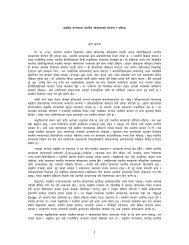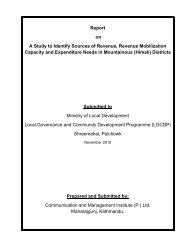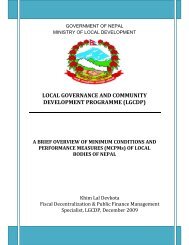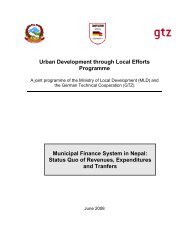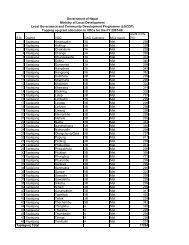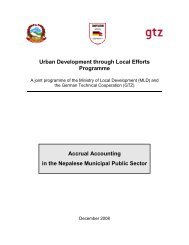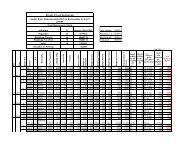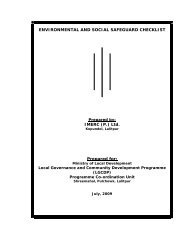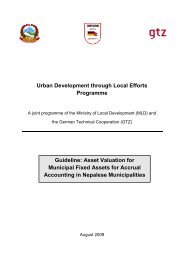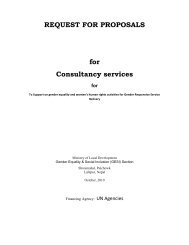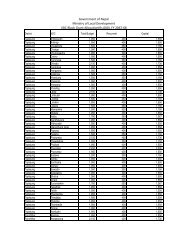GTZ Report on Proposal for Nepal Grant Formula - LGCDP
GTZ Report on Proposal for Nepal Grant Formula - LGCDP
GTZ Report on Proposal for Nepal Grant Formula - LGCDP
You also want an ePaper? Increase the reach of your titles
YUMPU automatically turns print PDFs into web optimized ePapers that Google loves.
<strong>Proposal</strong> <strong>for</strong> a municipal grant allocati<strong>on</strong> <strong>for</strong>mula 17<strong>Formula</strong>e deoiniti<strong>on</strong> <strong>for</strong> unc<strong>on</strong>diti<strong>on</strong>al grants• favour those local governments that exploit best their local tax bases and achieve full cost recovery of services rendered <strong>on</strong> a fee-‐basis to citizens.• encourage local governments to invest more in better tax coverage rates and in better tax collecti<strong>on</strong> rates. Tax coverage rates show the amount of potential exploitati<strong>on</strong> of a given revenue title, while tax collecti<strong>on</strong> rate refers <strong>on</strong>ly to the collecti<strong>on</strong> of receivables from registered and assessed tax payers.The key problem is to estimate the "tax capacity" within a local government. A report of the Australian Government <strong>on</strong> Assessing Local Government Revenue Raising Capacity of 2008 stated that “ultimately the observed revenue-‐raising ef<strong>for</strong>ts of local governments are driven by the demands of their com-munities <strong>for</strong> local government services. However, there are reas<strong>on</strong>s why it is difoicult to estimate dir-ectly the extent to which various characteristics of communities ‘explain’ differences in observed rev-enue-‐raising ef<strong>for</strong>ts. Am<strong>on</strong>g other things, this is because of:• the difoiculty in linking the rates paid by local residents to the services they use, which means there is no observable price <strong>for</strong> each of the services used• the substantial variati<strong>on</strong> in the mixes and levels of goods and services provided by councils• the complexity and variati<strong>on</strong> across councils in the system of rates, and of user fees and charges, levied by councils• the limitati<strong>on</strong>s of the data available.”For <strong>Nepal</strong>, these limitati<strong>on</strong>s are valid in principle, yet less important, as the four main issues raised do not apply as such or as much as in industrialised countries. The ef<strong>for</strong>ts local councils may take to in-crease revenue may be limited due to low ability or willingness to pay, whereby willingness can be ad-dressed politically, and low ability would result into no supplement to the basic amount allocated. The more per capita revenue is raised in selected taxes, which are at the same rate throughout the country, indicates local ef<strong>for</strong>ts. However, this holds true <strong>for</strong> n<strong>on</strong>-‐volatile taxes <strong>on</strong>ly such as land and building taxes. More ec<strong>on</strong>omically active local governments, or those that are close to the main trade routes in <strong>Nepal</strong>, may have higher per capita revenues as compared to those with very little ec<strong>on</strong>omic and taxable activities. There<strong>for</strong>e, a systems has to be found that balances the tax capacity and the actual tax per capita income of local governments.4.1.3 Socio-ec<strong>on</strong>omic c<strong>on</strong>diti<strong>on</strong>In 2009, the grant allocati<strong>on</strong> <strong>for</strong>mulae used by Government relied <strong>on</strong> the Human Development Index. There are fundamental critics how the HDI is being used and especially, how the subsequent allocati<strong>on</strong> occurs (see Steffensen 2009). The critics are str<strong>on</strong>gly supported here. For municipalities, there is no HDI data available, and the use of district data instead is not regarded as feasible. As l<strong>on</strong>g as there is no c<strong>on</strong>sistent and reliable data base, the Government should refrain from using this and similar indicators to avoid severe imbalances or inequalities. 4.2 Minimum C<strong>on</strong>diti<strong>on</strong>s and Per<strong>for</strong>mance Measurement <strong>for</strong>mula de[initi<strong>on</strong>The MCPM grant is unc<strong>on</strong>diti<strong>on</strong>al and is oixed to 50% of the available gross funds <strong>for</strong> unc<strong>on</strong>diti<strong>on</strong>al grants. Dr Alexander Wegener interpublic c<strong>on</strong>sultancywww.interpublic-‐berlin.de



